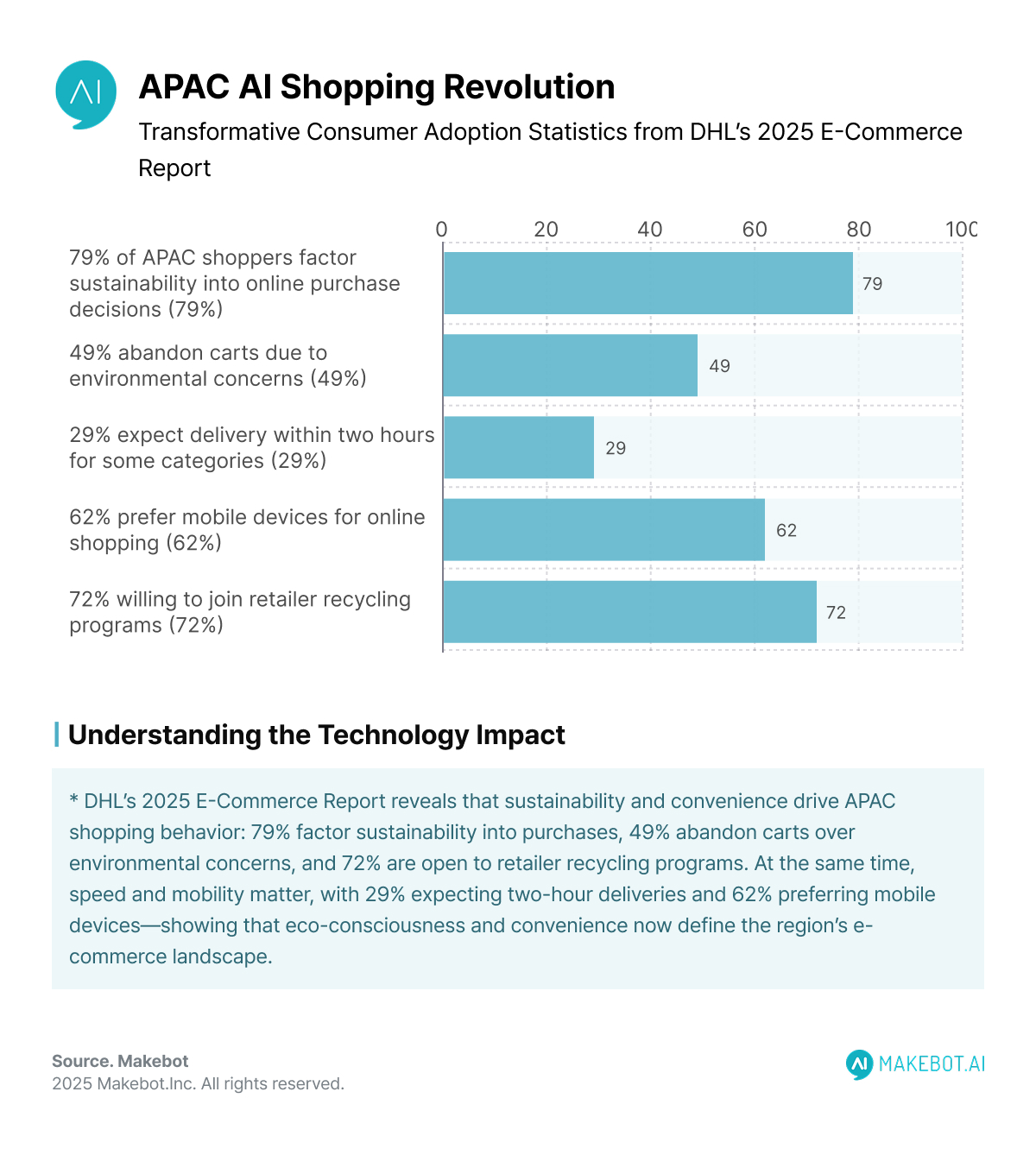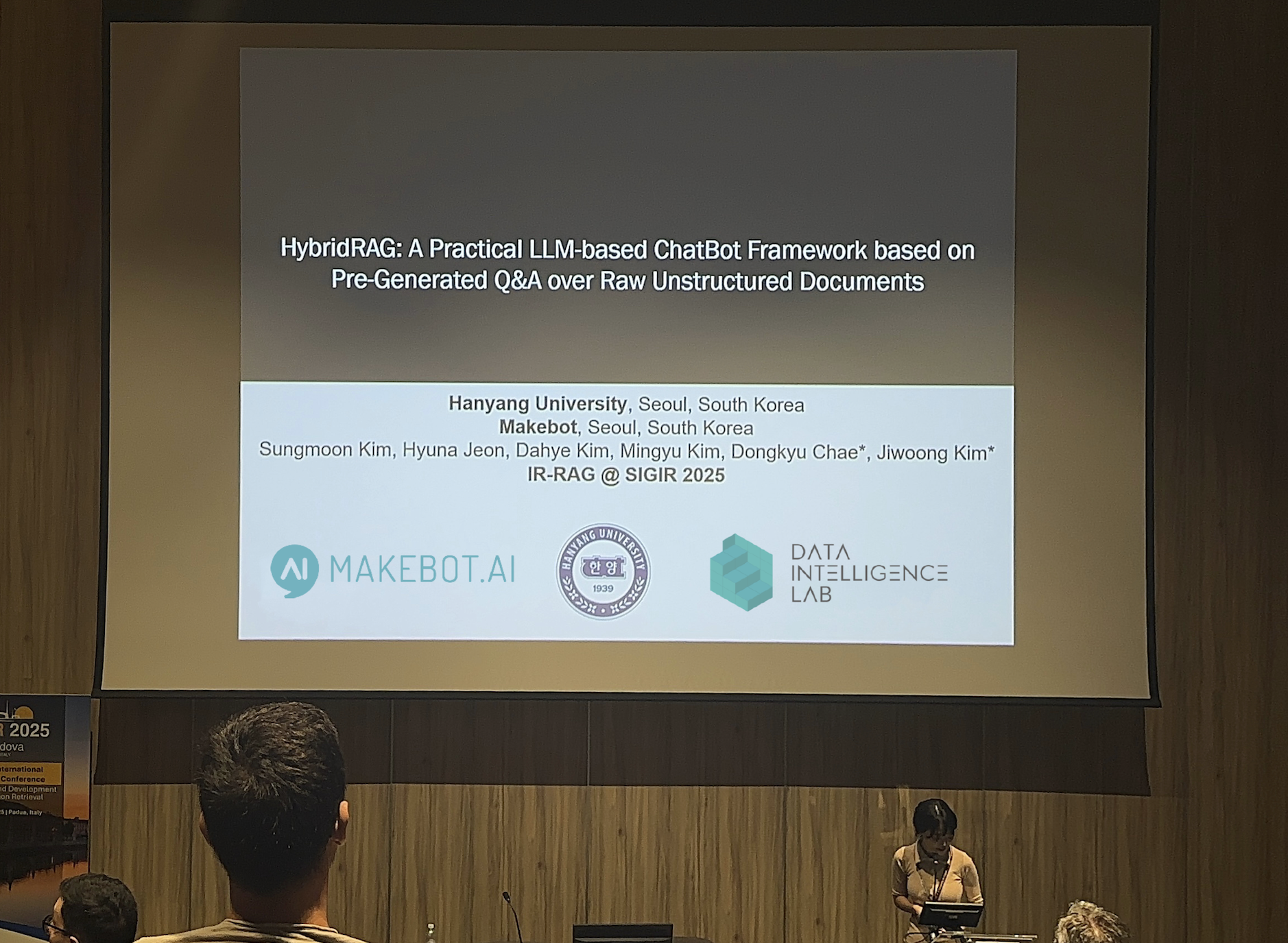The AI Shopping Revolution: 81% of APAC Consumers Demand AI-Powered Tools
81% of APAC consumers demand AI-powered shopping tools—AI is now core to retail expectations


The digital commerce landscape in Asia Pacific is undergoing a seismic transformation, driven by consumer expectations that have evolved far beyond traditional online shopping experiences.
According to DHL eCommerce's comprehensive 2025 E-Commerce Trends Report, which surveyed 24,000 online shoppers across 24 global markets, 81% of APAC shoppers now actively want retailers to offer AI-powered shopping tools – marking artificial intelligence as no longer a luxury feature but a fundamental consumer expectation.
Deloitte Report : AI Governance Improvement Opportunities in the APAC Region. Read more here!

The Scale of AI Adoption in APAC Markets
The data reveals a striking regional divergence in AI innovation adoption. While global markets show varying levels of AI acceptance, APAC demonstrates unprecedented enthusiasm for AI tools integration across the shopping journey. This 81% demand rate significantly outpaces many Western markets, positioning Asia Pacific as the global epicenter for AI-driven retail transformation.
The consumer preference for AI-powered shopping tools extends beyond mere curiosity. 47% of APAC shoppers are already making purchases through voice commands, demonstrating that hands-free, conversational commerce has moved from experimental to mainstream adoption. This behavioral shift indicates that Generative AI applications in retail are not just meeting current needs but actively reshaping how consumers expect to interact with brands.
Technical Implementation Priorities
The research identifies specific AI tools that resonate most strongly with APAC shoppers:
Virtual Try-On Technology
Leading consumer demand, this application leverages computer vision and augmented reality to allow shoppers to visualize products before purchase. The technology addresses the fundamental e-commerce challenge of product uncertainty, particularly crucial for fashion and beauty categories that dominate APAC online spending.
AI-Powered Shopping Assistants
These conversational interfaces utilize natural language processing to guide purchase decisions, answer product queries, and provide personalized recommendations based on browsing history and stated preferences.
Voice-Enabled Product Search
With 47% of APAC consumers already shopping via voice commands, this technology represents the most mature AI application in the region. Voice search capabilities must integrate with local languages, dialects, and cultural nuances across diverse Asia Pacific markets.
AI Investment a Top Priority for Asia-Pacific Entrepreneurs, UBS Report Finds. More here!
Regional Market Variations and Social Commerce Integration
The social commerce phenomenon amplifies AI adoption across APAC markets. 85% of Asia Pacific consumers expect to shop primarily through social media platforms by 2030, with 87% reporting that viral trends and social buzz influence their buying decisions. This convergence of social discovery and AI-enhanced purchasing creates unique technical challenges and opportunities.
TikTok's dominance varies significantly across markets: 86% of Thai shoppers and 81% of Malaysian consumers report making purchases through the platform, while China shows distinct preferences for Douyin (89%) and WeChat (76%). This fragmentation requires retailers to implement platform-specific AI solutions rather than universal approaches.
The Delivery and Returns Infrastructure Challenge
Despite the focus on front-end AI experiences, fundamental logistics concerns continue to drive conversion rates. 77% of APAC shoppers abandon carts when preferred delivery options are unavailable, while 75% exit if return processes don't meet expectations. This data suggests that AI innovation must extend beyond customer-facing features to encompass supply chain optimization and predictive logistics.
The trust factor remains critical: 65% of consumers refuse to purchase from retailers using returns providers they don't trust. This statistic highlights the need for AI systems to provide transparent, reliable information about logistics partners and delivery timelines.

Sustainability Integration and Circular Economy AI
79% of APAC shoppers now factor sustainability into online purchase decisions, with 49% abandoning carts due to environmental concerns. This trend creates opportunities for AI-powered shopping tools to integrate sustainability metrics directly into the purchasing process.
The circular economy presents specific AI applications: 52% of consumers opt for pre-owned or refurbished goods, while 72% express willingness to participate in retailer-run recycling programs. Generative AI can optimize these processes by matching consumers with sustainable alternatives, calculating environmental impact scores, and facilitating circular commerce workflows.
Implementation Challenges and Technical Considerations
The mobile-first nature of APAC commerce creates specific technical requirements. 62% of Asia Pacific consumers prefer mobile devices for online shopping, yet many find mobile experiences frustrating. 70% believe brands should work harder to improve mobile experiences, indicating that AI implementation must prioritize mobile optimization over desktop experiences.
The speed expectations are extreme: 29% of APAC consumers expect delivery within two hours for certain categories. This demands AI systems capable of real-time inventory management, dynamic pricing adjustments, and predictive demand forecasting across multiple fulfillment centers.
Cross-Border Commerce and Payment Integration
98% of Singapore shoppers express comfort with cross-border purchases, significantly above the 89% global average. This international shopping behavior requires AI tools that can handle multiple currencies, tax calculations, international shipping logistics, and regulatory compliance across different markets.
Payment preferences vary dramatically: while 71% use credit cards, 52% prefer digital wallets, and 67% use different payment methods for local versus international purchases. AI-powered shopping tools must dynamically adapt payment options based on purchase origin, destination, and consumer history.
Future Technical Roadmap and Strategic Implications
The convergence of multiple technologies creates unprecedented opportunities for AI innovation in APAC retail. 91% of Asia Pacific consumers identify as gamers, with 70% spending money in-game. This gaming commerce trend suggests that virtual environments and digital asset transactions will become significant components of AI-powered retail strategies.
The emergence of "post-death consumerism" – with over half of APAC consumers expressing interest in such services – indicates that Generative AI applications may extend far beyond traditional retail boundaries into digital legacy and virtual relationship management.
Strategic Recommendations for Retailers
The data suggests three critical implementation priorities:
- Platform-Specific AI Development: Rather than universal solutions, retailers must develop AI capabilities tailored to specific social platforms, payment systems, and regional preferences across Asia Pacific markets.
- Mobile-Native AI Architecture: Given mobile dominance and experience gaps, AI-powered shopping tools must be designed from the ground up for mobile interfaces, not adapted from desktop experiences.
- Integrated Sustainability Intelligence: As environmental concerns drive purchase decisions, AI systems must incorporate sustainability scoring, circular economy options, and environmental impact calculations as core features rather than add-ons.
The 81% demand rate for AI-powered shopping tools among APAC shoppers represents more than consumer preference – it signals a fundamental shift in retail expectations that will define competitive advantage in the world's most dynamic e-commerce markets.
Showcasing Korea’s AI Innovation: Makebot’s HybridRAG Framework Presented at SIGIR 2025 in Italy. More here!
From AI Potential to Real Retail Impact with Makebot
APAC shoppers have made it clear: Generative AI and AI-powered shopping tools are no longer optional—they are the future of commerce in Asia Pacific. Yet many retailers are struggling to bridge the gap between consumer expectations and technical execution.
This is where Makebot bridges the gap. We go beyond technology delivery, providing industry-specific LLM agents and end-to-end AI solutions tailored to your business strategy and goals.
Why Choose Makebot?
- Industry-Specific LLM Agents: From healthcare agents used by leading hospitals like Seoul National University Hospital and Gangnam Severance Hospital, to solutions for finance, retail, and the public sector, Makebot delivers customized AI you can trust.
- Ready-to-Deploy AI Solutions: Upgrade or replace your chatbot with BotGrade, enhance customer service with MagicTalk, process complex data with MagicSearch, or automate 24/7 voice consultations through MagicVoice.
- Rapid PoC to Deployment: Quickly transform ideas into proof of concept and scale to production—maximizing adoption speed and ROI.
- Global-Verified Technology: With HybridRAG, presented at SIGIR 2025, Makebot achieved a 26.6% accuracy improvement and up to 90% cost reduction, setting new global benchmarks. Backed by multiple LLM/RAG patents and trusted by over 1,000 enterprises, we deliver stability and proven impact.
Generative AI is no longer just an innovation—it’s a core growth engine. With Makebot, you can move strategically from exploration to execution and turn AI potential into measurable business results.
👉 Start your AI journey today: www.makebot.ai
📩 Contact us at b2b@makebot.ai to discuss how we can help you lead the AI shift.

Studies Reveal Generative AI Enhances Physician-Patient Communication



































_2.png)


















.jpg)




































